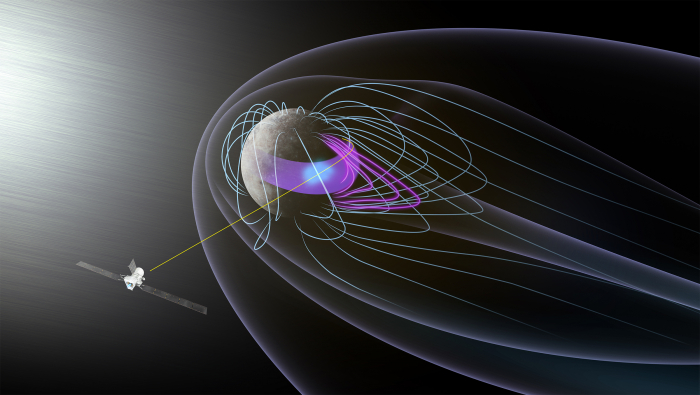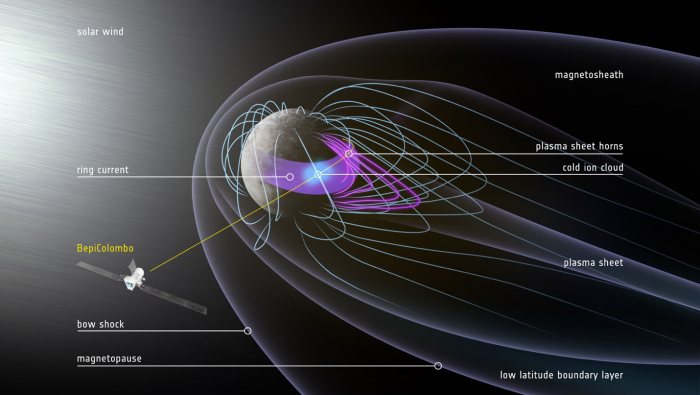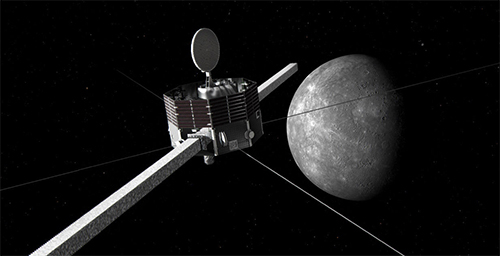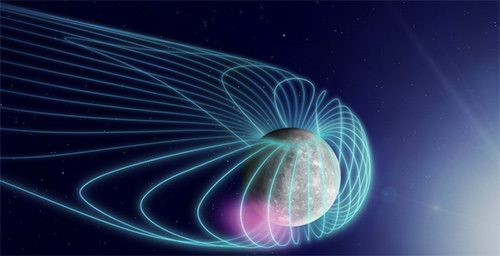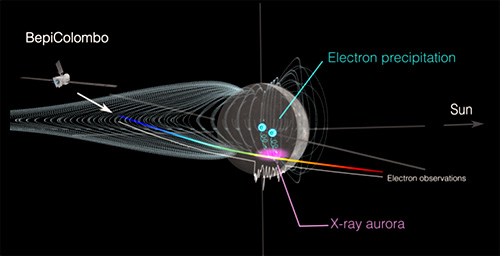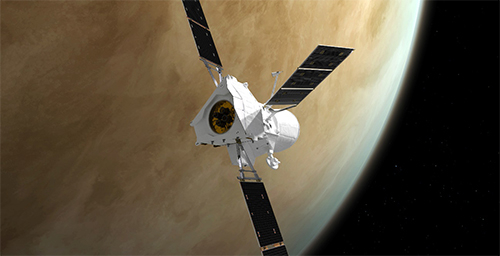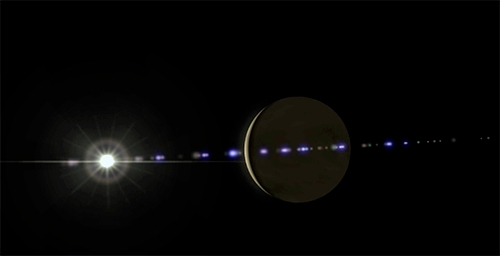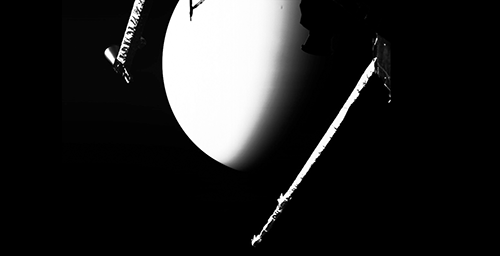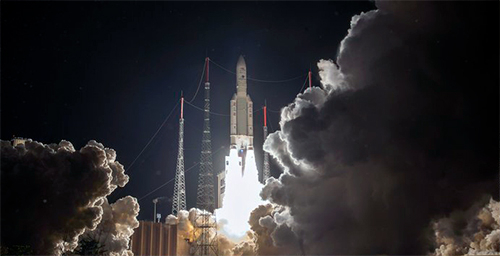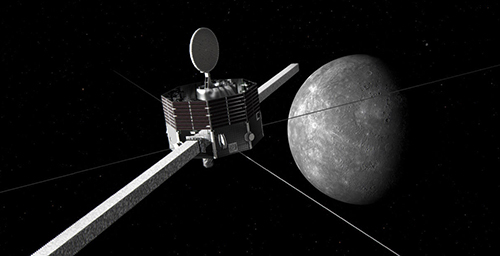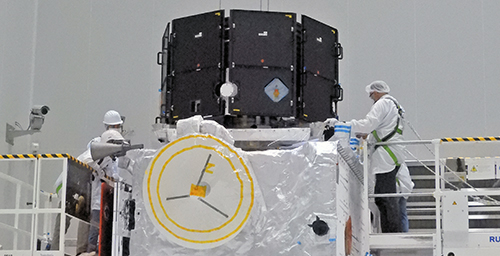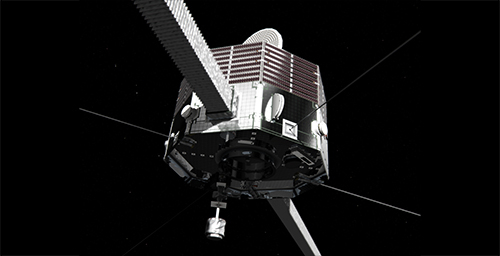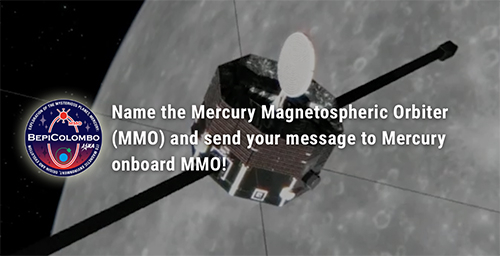Credit: ESA
BepiColombo is a joint mission to explore the planet Mercury by the European Space Agency (ESA) and the Japan Aerospace Exploration Agency (JAXA). On June 20, 2023 (JST), the spacecraft sped through the magnetosphere of Mercury during the third of six swing-bys of the planet, before the planned rendezvous in 2026.
The BepiColombo spacecraft consists of the ESA Mercury Planetary Orbiter (MPO) and the JAXA Mercury Magnetospheric Orbiter (MIO). The two probes will orbit Mercury after arrival in 2026, and are currently in a stacked configuration during the interplanetary journey. During the swing-by, the Mass Spectrum Analyzer (MSA), Mercury Ion Analyzer (MIA), and the Mercury Electron Analyzer (MEA) which are part of the Mercury Plasma Particle Experiment (MPPE) instrument suite onboard MIO made scientific observations in the vicinity of the planet. Combining these measurements with a computer model to determine the origin of the ions based on their motion, features of the magnetosphere along the spacecraft trajectory were revealed.
Mercury generates a planetary magnetic field, but this is only about 1/100th of the strength of the Earth's magnetic field at the planet surface. Nevertheless, the magnetic field forms a barrier-like structure around the planet that is known as the "magnetosphere". The magnetosphere acts as a buffer against the solar wind; a stream of charged particle plasma emitted by the Sun. Due to Mercury's proximity to the Sun, this interaction between the solar wind and planet magnetosphere is much stronger than for the Earth. The mission goal for MIO is to investigate how a planetary magnetosphere that surrounds the planet responds to the intense hammering of a solar wind.
A planetary swing-by is an operation that efficiently changes the orbit of the spacecraft by utilizing the gravity of the planet. The swing-by orbit is different to the orbit that will be taken after arrival at Mercury, and so provides an opportunity to observe areas around the planet that will not be covered during later routine observations. However, observations during the swing-by are limited for MIO, as the spacecraft is covered with solar shield which restricts the field of view. The third Mercury swing-by crossed Mercury's magnetosphere in about 30 minutes, and passed just 235 km from the planet surface.
Figure 1: Depiction of Mercury's magnetosphere seen by BepiColombo during the third Mercury swing-by. The spacecraft first reaches the bow shock on June 20, 2023 at 03:44:22 JST, and passed through the magnetosphere interface at 04:14:00. From 04:10:30 to 04:27:34, plasma particles at different energies were observed in the low-latitude boundary layer on the evening side of the planet. Immediately following this, at 04:28:31, BepiColombo entered a region called the plasma sheet horn, where the plasma sheet connects to the Mercury high latitude region, and successfully observed hot ions and electrons. From 04:32:00 to 04:44:04, the spacecraft observed high-energy ions and electrons near the equatorial plane and at low latitudes. These features strongly suggest that BepiColombo passed through Mercury's ring current. Credit: ESA.
During the first half of the swing-by, the instruments onboard MIO observed the shock boundary between the free-flowing solar wind and the magnetosphere. This structure is known as the low-latitude boundary layer and was predicted to be observed. However, the measured particles had a wider range of energies than expected, based on observation that had been made by the previous NASA MESSENGER mission.
High energy ions (positively charged particles) trapped in the magnetosphere were observed near the equatorial plane of the planet at low latitudes. These are thought to be partial or complete ring currents. Ring currents are electric currents carried by charged particles that are trapped in the magnetosphere. On Earth, ring currents exist tens of thousands of kilometres above the surface of the planet.
As Mercury's magnetosphere is small relative to the size of the planet, it is not clear how particles continue to be trapped where they were observed within a few hundred kilometres of the planet surface. Due to observational constraints during the swing-by, this study was not able to reveal a detailed picture of the ring current, but more information should be revealed once MPO and MIO are in orbit.
Ions originating from the planet, which is a particular target of MIO's MSA instrument, were also observed. Planetary origin ions are ionised neutral particles that have been ejected from Mercury's surface during micrometeorite impacts and interactions with the solar wind. Observing these planet-derived ions is synonymous with investigating how the planet surface and surrounding plasma environment are connected, so more observations are expected in the future.
The fourth BepiColombo Mercury swing-by occurred on September 4, 2024 JST. The fifth and sixth swing-bys will be conducted in December 2024 and January 2025, and the spacecraft will be injected into orbit around Mercury in November 2026.
Collaborative observation plans for the two orbiters after arrival at Mercury are being closely studied, along with observations with spacecraft that explore the inner heliosphere, such as ESA's Solar Orbiter and NASA's Parker Solar Probe.
The results from the third Mercury swing-by shown in this study have been published Nature Communications Physics on October 3, 2024:
"Mercury's plasma environment after BepiColombo's third flyby", Lina Z. Hadid et al https://doi.org/10.1038/s42005-024-01766-8
The analysis of the results was conducted by an international research team from JAXA's Institute of Space and Astronautical Science, the Institute of Plasma Physics (France), Kyoto University, the Institute of Astrophysics and Planetary Science (France), the University of Michigan, Osaka University, the Max Planck Institute for Solar System Research (Germany), the Institute for Atmospheric and Space Studies (France), and Kanazawa University.
For more details, please see the ESA website.

